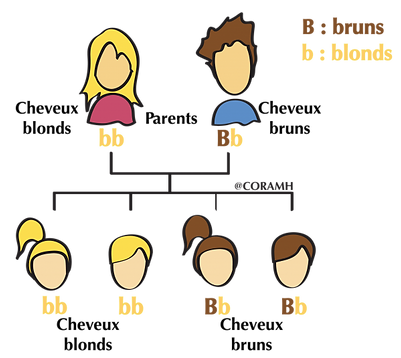Genetic concepts
Concepts of genetics and heredity
Every human being is made up of billions of cells, and each cell contains a nucleus. This nucleus contains all hereditary information in the form of chromosomes. A chromosome is a long, coiled DNA molecule.

Chromosomes
A human genome (set of genes and chromosomes) has 46 chromosomes in each of its cells, or 23 pairs. For each pair, one chromosome comes from the father and the other from the mother. The first 22 pairs are called autosomal chromosomes. The 23rd pair determines an individual's sex. These are the X and Y sex chromosomes. The human genome has over 25,000 genes.

DNA and genes
DNA is a molecule containing genetic information. DNA can be compared to a book that is unique to each person. This book is written in a language whose words consist of 4 letters: A, T, C, G. A gene is a piece of DNA formed by the precise sequence of several of these letters; this sequence of letters forms the gene sequence. There are more than 25,000 genes in the human genome that code for different physical characteristics and control the functioning of the body. Genes therefore influence development and contribute to the state of health of the individual at all stages of his life.

Dominant gene
A dominant gene imposes its instructions as soon as it is present and prevents the other gene from expressing its own. Only one copy of a dominant gene is needed for it to be expressed.
In this example, the "brown hair" gene is dominant.

Recessive gene
A recessive gene must be present in two copies for it to express its instructions.
In this example, the gene for "blond hair" is recessive.

Genetic diseases
A genetic disease is caused by one or more genetic defects (mutations) or by a chromosomal abnormality. There are several types of genetic diseases.
Some genetic diseases, called chromosomal disorders, are caused by defects in the chromosomes. These defects can occur due to the inaccurate number or structure of the chromosomes. For example, Down syndrome is caused by the presence of a third chromosome, chromosome 21.
Other genetic diseases are caused by the interaction of environmental and genetic factors, these are multifactorial diseases. That is, a gene alone cannot cause the disease, however it increases an individual's risk of developing it. If this gene is combined with other genetic or environmental factors, it is possible for the disease to develop. This is the case for several common diseases such as asthma, type 1 and 2 diabetes, certain types of cancer, cardiovascular disease, obesity, schizophrenia, Alzheimer's and multiple sclerosis to name a few.
Sometimes an error occurs in DNA, that is, a mutation. This occurs through the replacement, repetition, or absence of a letter in the DNA. Some of these errors can alter the functioning of a gene and cause a genetic disease. When these mutations are transmitted from one generation to the next, that is, from parents to children, these genetic diseases are said to be hereditary. This is the case for the seven diseases that are highly prevalent in Saguenay–Lac-Saint-Jean. We can group these hereditary diseases into two broad categories based on the mode of transmission:
Sources: Genetics and Heredity – CORAMH


